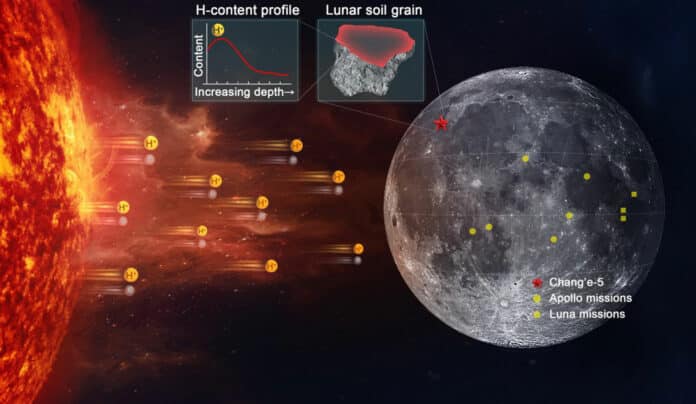Remote sensing data revealed that water (OH/H2O) on the Moon is latitude-dependent and probably time-of-day variation. It suggests that a solar wind originated water with a high degassing loss rate on the lunar surface.
However, it is still being determined whether or not the solar wind-derived water in lunar soil grains can be preserved beneath the surface. The abundance, distribution, and origin of lunar surface water have recently drawn much interest because of its critical significance in upcoming space exploration.
The Chang’e-5 lunar soil grain rims have high hydrogen concentrations and low deuterium/hydrogen (D/H) ratios, which are consistent with lunar water originating from the solar wind, according to a joint research team from the National Space Science Center (NSSC) and the Institute of Geology and Geophysics (IGG), both affiliated with the Chinese Academy of Sciences (CAS).
The researchers simulated the retention of hydrogen in lunar soils at various temperatures. They discovered that the lunar surface’s middle and high latitude portions could effectively maintain solar wind-originated water.
Prof. LIN Yangting from IGG, the corresponding author of the study, said, “The polar lunar soils could contain more water than Chang’e-5 samples.”
The Chang’e-5 mission returned soil samples from a place at a middle latitude (43.06°N), in contrast to the six Apollo and three Luna missions, which all touched down at low latitudes (8.97°S—26.13°N). The Chang’e-5 samples were also taken from the driest basaltic basement and the youngest known lunar basalts (2.0 Ga). To address the spatial-temporal distribution and retention of SW-derived water in the lunar regolith, Chang’e-5 samples are essential.
The researchers performed deuterium/hydrogen ratio calculations and NanoSIMS depth profiling measurements on 17 lunar soil grains recovered by the Chang’e-5 mission.
The majority of the grain rims (topmost 100 nm) had exceptionally low D values (-908 to -992) and high hydrogen concentrations (1,116–2,516 ppm), which suggested an SW origin, according to the results. The bulk SW-derived water content for the Chang’e-5 lunar soils was estimated to be 46 ppm, which is comparable with the remote sensing result based on the grain size distribution of the lunar soils and their hydrogen content.
Heating tests on a portion of the grains showed that the hydrogen incorporated by the SW could be maintained after burial. The researchers created a model of the dynamic equilibrium between the implantation and outgassing of SW-hydrogen in lunar soil grains using this data and prior studies, demonstrating that temperature (latitude) is a crucial factor in the implantation and migration of hydrogen in lunar soils.
Prof. LIN said, “Using this model, they predicted an even higher abundance of hydrogen in the grain rims in the lunar polar regions. This discovery is of great significance for the future utilization of water resources on the Moon. Also, through particle sorting and heating, it is relatively easy to exploit and use the water contained in the lunar soil.”
Journal Reference:
- Yuchen Xu et al. High abundance of solar wind-derived water in lunar soils from the middle latitude. PNAS. DOI: 10.1073/pnas.2214395119
